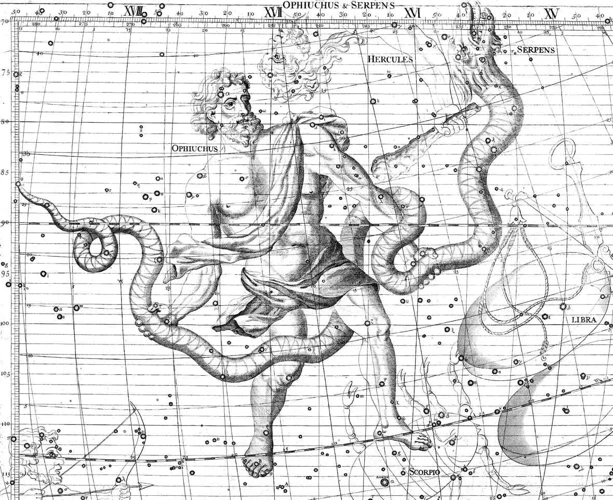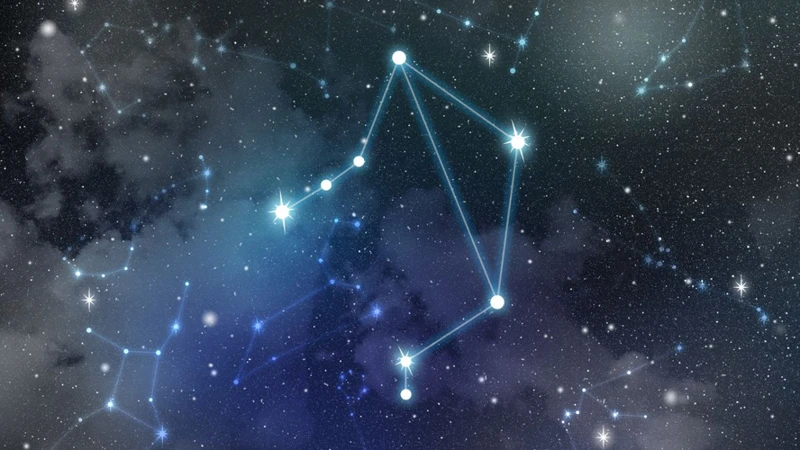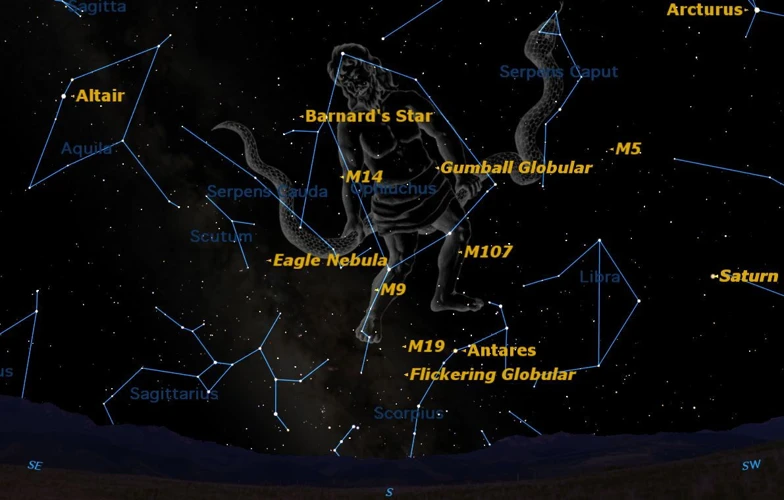Have you ever looked up at the night sky and wondered what lies beyond the familiar constellations? Enter Ophiuchus, an enigmatic constellation that sparks intrigue and curiosity among both astronomers and astrology enthusiasts alike. Although not widely known or recognized, Ophiuchus has a rich history and a fascinating astronomical perspective that warrants exploration. In this article, we will delve into the origins of Ophiuchus, its position and visibility in the night sky, its connections to astrology, and its scientific significance. Join us as we unravel the mysteries of Ophiuchus and discover the wonders of this celestial wonder.
Contents
- The History of Ophiuchus
- Ophiuchus in the Night Sky
- Connections to Astrology
- Scientific Significance and Studies
- Conclusion
-
Frequently Asked Questions
- What is the significance of Ophiuchus?
- Why is Ophiuchus not commonly known?
- Can Ophiuchus be seen with the naked eye?
- What are the main stars in Ophiuchus?
- Is Ophiuchus associated with any mythological stories?
- What is the controversy surrounding Ophiuchus in astrology?
- Are there personality traits associated with Ophiuchus?
- What is the scientific significance of Ophiuchus?
- Can Ophiuchus be observed with a telescope?
- Are there any ongoing studies or research on Ophiuchus?
- References
-
Frequently Asked Questions
- 1. How did Ophiuchus get its name?
- 2. Why is Ophiuchus not commonly recognized as a constellation?
- 3. What are the mythological associations with Ophiuchus?
- 4. Is Ophiuchus visible from all parts of the world?
- 5. What are the prominent stars in the constellation Ophiuchus?
- 6. Are there any interesting objects to observe within Ophiuchus?
- 7. What is the controversy surrounding Ophiuchus in astrology?
- 8. How does Ophiuchus influence personality traits and characteristics?
- 9. What is the scientific significance of studying Ophiuchus?
- 10. Can Ophiuchus be seen with the naked eye?
- References
- Read More
The History of Ophiuchus

The History of Ophiuchus is a captivating journey that takes us back to ancient times. The Origin of the Name Ophiuchus can be traced back to Greek mythology, where it is said to represent a legendary healer, Asclepius. Asclepius was highly skilled in the art of medicine and was honored for his ability to revive the dead. This association with healing and restoration led to the depiction of a snake entwined around a staff, known as the Rod of Asclepius, which became the symbol of medicine. Ancient Depictions and Interpretations of Ophiuchus can be found in various cultures, including Egyptian and Babylonian astronomy, where it was seen as representing a serpent or a snake-handler. In ancient Rome, Ophiuchus was sometimes associated with Aesculapius, the Roman counterpart of Asclepius, highlighting the influence of Greek mythology on Roman culture. Recognition by Modern Astronomy came much later, as the International Astronomical Union officially recognized Ophiuchus as one of the 88 constellations in 1930. This acknowledgement solidified Ophiuchus’ place in modern astronomy, allowing it to be studied and observed with more precision. The history of Ophiuchus is a testament to the enduring fascination humans have with the stars and the stories they tell.
The Origin of the Name
The Origin of the Name Ophiuchus can be traced back to Greek mythology. In Greek, “Ophiuchus” means “serpent bearer” or “snake handler.” This name is closely associated with the legendary healer, Asclepius. According to myth, Asclepius was the son of Apollo, the Greek god of healing, and a mortal woman named Coronis. Asclepius gained immense knowledge and skill in the medical arts and became known for his ability to heal the sick and even bring the dead back to life. However, his powers and success drew the attention of Zeus, the king of the gods, who feared the imbalance it would create between life and death. As a result, Zeus struck down Asclepius with a bolt of lightning. In honor of his extraordinary abilities, Asclepius was immortalized in the heavens as the constellation Ophiuchus, forever holding the Serpent or snake-handler. The name Ophiuchus is a testament to the mythology and storytelling traditions of the ancient Greeks, where characters and their deeds were immortalized in the stars for all to see and remember.
Ancient Depictions and Interpretations
Ancient Depictions and Interpretations of Ophiuchus provide us with fascinating insights into the cultural beliefs and mythologies of various civilizations. In Egyptian astronomy, Ophiuchus was associated with the serpent god Wadjet, often portrayed as a cobra. The presence of Ophiuchus in Egyptian astronomy signifies the reverence and fear associated with snakes in their religious beliefs. In Babylonian astronomy, the constellation was associated with the serpent-bearer, representing their god Nergal, who was linked to underworld deities. The Babylonians saw Ophiuchus as a powerful figure with control over both life and death. The Romans, influenced by Greek mythology, often associated Ophiuchus with Aesculapius, the god of healing and medicine. Aesculapius was known for his ability to cure the incurable and was often depicted with a staff entwined by a serpent, which later became the symbol of medicine. These ancient depictions and interpretations showcase the diverse mythological connections and beliefs surrounding Ophiuchus across different civilizations throughout history. To learn more about Roman mythology, you can explore our article on Major Gods and Goddesses in Roman Mythology and discover the intriguing world of myth-creatures in Roman Mythology.
Recognition by Modern Astronomy
The Recognition by Modern Astronomy of Ophiuchus as a constellation marked a significant milestone in our understanding of the night sky. Prior to its recognition, Ophiuchus was often overlooked or considered as part of the neighboring constellations. However, in 1930, the International Astronomical Union officially designated Ophiuchus as one of the 88 constellations. This recognition allowed astronomers to study Ophiuchus more closely and led to the inclusion of its celestial coordinates in star catalogs and observatories. Ophiuchus occupies an area of the sky between the constellations of Scorpius and Sagittarius, providing astronomers with a clear delineation of its boundaries. With modern technology and advancements in observation techniques, astronomers have been able to identify and catalog numerous stars, clusters, and nebulae within the Ophiuchus constellation. The recognition of Ophiuchus by modern astronomy has not only contributed to our knowledge of the cosmos but also sparked curiosity and interest in exploring this fascinating celestial region.
Ophiuchus in the Night Sky

Ophiuchus in the Night Sky holds a position of celestial prominence and offers a unique spectacle for stargazers. Positioned near the celestial equator, Ophiuchus can be found between the constellations of Scorpius and Sagittarius. Its location makes it visible in both the northern and southern hemispheres, allowing a wide range of observers to marvel at its splendor. Ophiuchus is adorned with several notable stars, including Rasalhague, the brightest star in the constellation, known for its bluish-white appearance. Other stars within Ophiuchus have significant mythological associations, such as Sabik, which represents the snake holder’s left shoulder. Along with its stars, Ophiuchus is associated with clusters and nebulae that add to its ethereal charm. One such example is the Ophiuchus Cluster, a massive group of galaxies located within the constellation. Observing Ophiuchus in the night sky provides an opportunity to witness the beauty and grandeur of this often-overlooked constellation and its cosmic companions. Whether you are an astronomy enthusiast or a casual stargazer, Ophiuchus offers a captivating spectacle that is well worth exploring.
Position and Visibility
Position and Visibility of Ophiuchus in the night sky make it an intriguing constellation to locate and observe. Ophiuchus lies between the constellations of Scorpius and Sagittarius, positioned near the celestial equator. This means that it is visible from most parts of the world. To locate Ophiuchus, one can look towards the southern horizon during the summer months in the Northern Hemisphere or the winter months in the Southern Hemisphere. Ophiuchus is most easily visible during the late evening or early morning hours between May and July. However, due to its proximity to the ecliptic, the path the Sun appears to take across the sky, Ophiuchus is often overshadowed by the prominent constellations of the zodiac. Nonetheless, with a clear, dark sky and a little patience, Ophiuchus can be found and appreciated for its unique position in the celestial tapestry.
Stars and Mythological Associations
Stars and Mythological Associations play a significant role in understanding Ophiuchus. One of the prominent stars in this constellation is Rasalhague, which is also known as Alpha Ophiuchi. It is a binary star system consisting of a blue-white primary star and a yellow-white secondary star. Another notable star is Barnard’s Star, one of the closest stars to our solar system at a distance of about 6 light-years.
Mythological associations with Ophiuchus are diverse and intriguing. In Greek mythology, Ophiuchus is often identified with Asclepius, the god of healing and medicine. According to the myth, Asclepius was the son of Apollo and was taught the secrets of medicine by the centaur Chiron. Asclepius became so skilled in healing that he could even bring the dead back to life, which angered Hades, the god of the underworld. As a result, Zeus struck him down with a thunderbolt, but feeling remorseful, Zeus eventually placed Asclepius among the stars as the constellation Ophiuchus.
In Egyptian mythology, Ophiuchus has associations with the serpent goddess Wadjet, who was believed to bring protection, vitality, and healing to the pharaohs. The serpent symbolism in this constellation represents wisdom, transformation, and the power of rejuvenation. These mythological associations add depth and meaning to the lore surrounding Ophiuchus, further connecting it to the ancient civilizations that celebrated the wonders of the cosmos.
Observing Ophiuchus
Observing Ophiuchus presents a unique opportunity for stargazers and astronomers alike. Due to its position along the celestial equator, Ophiuchus is visible from most parts of the world, making it accessible to a wide range of observers. To locate Ophiuchus, one can use neighboring constellations as celestial landmarks. Look for its proximity to the constellation Scorpius, with the bright red star Antares serving as a helpful guide. Ophiuchus also shares a border with the constellation Serpens, which is further divided into Serpens Caput and Serpens Cauda. Finding these surrounding constellations can assist in identifying Ophiuchus in the night sky. Once located, observers will be treated to a celestial spectacle. Ophiuchus is home to several notable stars, including Rasalhague, a binary system comprised of two stars that orbit each other. This makes Rasalhague an excellent target for telescope observation, as its stellar companions can reveal valuable insights into stellar evolution and dynamics. Additionally, Ophiuchus is associated with several fascinating deep-sky objects, such as the Ophiuchus Cluster, a region rich with young stars and stellar nurseries. Observing Ophiuchus provides an opportunity to witness the wonders of our universe and gain a deeper appreciation for the vastness of the cosmos. So grab a telescope or simply look up at the night sky, and let Ophiuchus guide you on a journey of astronomical exploration.
Connections to Astrology

Connections to Astrology have sparked both fascination and controversy. The Controversy Surrounding Ophiuchus arises from its potential disruption of the traditional zodiac system. Ophiuchus is said to fall within the ecliptic, the circular path followed by the Sun, Moon, and planets, and its presence raises questions about the inclusion of a 13th zodiac sign. However, it is important to note that the tropical zodiac system used in Western astrology is based on the division of the sky into 12 equal parts, each corresponding to a specific constellation. Ophiuchus and the Zodiac conundrum brings attention to the complexities of astrological systems and the interpretations of celestial influences on human lives. Despite the controversy, some astrologers have embraced Ophiuchus as a legitimate astrological sign, attributing personality traits and characteristics to individuals born during its assigned dates. Ophiuchans are described as seekers of knowledge, healers, and spiritual guides, with a deep connection to the mysteries of life. While the debate rages on, Ophiuchus continues to pique the interest of astrologers and enthusiasts, pushing the boundaries of traditional astrology and challenging our understanding of the celestial realm.
The Controversy Surrounding Ophiuchus
The Controversy Surrounding Ophiuchus has been a topic of debate among astrologers and astronomy enthusiasts. One aspect of this debate revolves around Ophiuchus and the Zodiac. Traditionally, the Zodiac consists of twelve signs, each representing a specific period of the year. However, some argue that Ophiuchus should be included as the thirteenth sign, disrupting the traditional Zodiac calendar. This controversy stems from the fact that Ophiuchus occupies a portion of the sky along the ecliptic, the apparent path of the Sun. Another point of contention is the Personality Traits and Characteristics associated with Ophiuchus. According to some astrologers, Ophiuchus individuals are said to possess traits such as intuition, healing abilities, and a strong sense of justice. However, critics argue that these traits are not adequately supported by scientific evidence. The controversy surrounding Ophiuchus highlights the ongoing dialogue between astrology and astronomy, where differing perspectives and interpretations collide. As we delve deeper into the mysteries of Ophiuchus, it’s important to approach the subject with an open mind and a willingness to explore new and diverse perspectives on the cosmos.
Ophiuchus and the Zodiac
Ophiuchus and the Zodiac have an intricate relationship that has stirred much controversy and debate in the world of astrology. Traditionally, the Zodiac consists of twelve signs, each corresponding to a specific period of the year. However, the introduction of Ophiuchus as a thirteenth constellation has challenged the established Zodiac system. Ophiuchus falls between Scorpio and Sagittarius and is said to occupy a period from November 29th to December 17th. Some astrologers argue that, in light of Ophiuchus’ inclusion, the dates for the other zodiac signs should be adjusted accordingly. However, many adherents of Western astrology maintain the twelve-sign system and dismiss Ophiuchus as not having a significant role. Ophiuchus and the Zodiac symbolize the ongoing evolution and interpretation of astrology, where different perspectives clash and harmonize. It is important to note that while some may resonate with the characteristics ascribed to Ophiuchus, others may find more alignment with their original zodiac sign. The impact of Ophiuchus on astrology continues to be a topic of discussion as individuals explore the mysteries of the stars and seek to understand their celestial influences. Link: Harmonizing Effects of Trine Aspects in Astrology.
Personality Traits and Characteristics
Personality Traits and Characteristics associated with Ophiuchus are a subject of much debate and speculation. While Ophiuchus is not officially recognized as one of the 12 zodiac signs in Western astrology, some astrologers have incorporated it into their interpretation. Those born between November 29 and December 17 are said to be influenced by Ophiuchus. People associated with Ophiuchus are often seen as seekers of knowledge and truth. They possess a deep passion for understanding the mysteries of the universe and are driven by a desire to heal and transform both themselves and the world around them. Ophiuchus individuals are believed to have strong intuitions and may possess healing abilities or a natural aptitude for the medical field. They are often seen as wise, philosophical, and inclined towards spirituality. Their quest for truth and personal growth can make them relentless, sometimes to the point of self-sacrifice. However, it’s important to note that these traits and characteristics can vary greatly depending on an individual’s specific birth chart and other astrological factors. It is always advisable to consult a professional astrologer for a personalized understanding of one’s astrological makeup.
Scientific Significance and Studies

Scientific Significance and Studies have shed light on the remarkable aspects of Ophiuchus, offering intriguing insights into stellar evolution and the exploration of celestial phenomena. Ophiuchus in Stellar Evolution has been the subject of extensive research, as it is home to several remarkable star-forming regions. These regions, known as Ophiuchus Molecular Cloud Complex, contain vast concentrations of gas and dust, providing a fertile ground for the birth of new stars. Scientists have used various telescopes and instruments to examine these regions, unraveling the complex processes of star formation and the evolution of protostellar objects. Exploring Ophiuchus Clusters and Nebulae has also been a focus of scientific studies. Within the constellation, there are several notable objects, such as the Barnard 59 and 68 dark nebulae, the Pipe Nebula, and the Snake Nebula. These clusters and nebulae hold valuable information about the interstellar medium, stellar nurseries, and the intricate interplay of gas, dust, and radiation in the cosmos. Through detailed observations and analysis, scientists aim to deepen our understanding of the formation and behavior of stars, as well as the larger-scale structures within the universe. The scientific significance of Ophiuchus serves to expand our knowledge and unravel the mysteries that exist within this extraordinary constellation.
Ophiuchus in Stellar Evolution
Ophiuchus in Stellar Evolution holds great significance in the study of cosmic processes. Within the constellation of Ophiuchus, there are several star-forming regions, known as stellar nurseries, where new stars are born. One such region is the Ophiuchus Molecular Cloud, a vast and dense interstellar cloud that serves as a cradle for star formation. This cloud contains protostars, which are young stars in the early stages of their evolution. As these protostars gather more mass from the surrounding gas and dust, they undergo gravitational collapse, eventually igniting nuclear fusion in their cores. This marks the birth of a new star, which will continue to evolve and shine brightly in the galaxy. Ophiuchus also hosts other stellar phenomena, such as massive stars that go through rapid evolutionary stages, from the main sequence to the red giant phase and eventually to supernova explosions. These stellar explosions release immense energy and matter into space, enriching the surrounding environment with heavy elements that are crucial for the formation of planets and supporting life as we know it. The study of Ophiuchus in stellar evolution provides valuable insights into the life cycles of stars, the processes that shape our universe, and the origins of celestial objects we observe and marvel at.
Exploring Ophiuchus Clusters and Nebulae
Exploring Ophiuchus Clusters and Nebulae reveals a wealth of celestial treasures within this enigmatic constellation. Ophiuchus is home to several notable stellar clusters and nebulae that offer glimpses into the intricate workings of the universe. One prominent cluster within Ophiuchus is Messier 10, also known as M10 or NGC 6254. This globular cluster is composed of thousands of stars tightly bound together by gravity, creating a beautiful spherical structure. Another remarkable cluster is NGC 6633, an open cluster consisting of younger, hot stars that illuminate the surrounding space with their brilliance. Nebulae are also abundant in Ophiuchus, such as the Pipe Nebula, a dark nebula that obscures the light from background stars, creating a striking silhouette against the starry backdrop. Additionally, the Snake Nebula (Barnard 72) is another fascinating nebula within Ophiuchus, showcasing intricate dust structures resembling a snake winding through space. Exploring these clusters and nebulae provides valuable insights into stellar evolution, the birth of new stars, and the expansive nature of the cosmos. So, grab a telescope and embark on a journey to witness the magnificence of Ophiuchus’ clusters and nebulae firsthand.
Conclusion

In conclusion, exploring the astronomical perspective of Ophiuchus unveils a constellation rich in history, mythological significance, and scientific relevance. From its origins in Greek mythology as the healer Asclepius to its recognition by modern astronomy, Ophiuchus has left an indelible mark on human imagination. Though often overlooked, this constellation is a testament to the vastness and complexity of the night sky. Whether you gaze at the stars with a scientific eye or seek cosmic guidance through astrology, Ophiuchus offers a unique perspective that invites us to ponder the mysteries of the universe. So, the next time you find yourself scanning the heavens, take a moment to appreciate the elusive and enigmatic Ophiuchus, a celestial wonder that awaits your curiosity and exploration.
Frequently Asked Questions

What is the significance of Ophiuchus?
Ophiuchus holds both historical and astronomical significance. It has roots in Greek mythology as the representation of the legendary healer Asclepius. In modern astronomy, it is recognized as one of the 88 constellations, adding to our understanding of the night sky.
Why is Ophiuchus not commonly known?
Ophiuchus may not be as well-known as other constellations because it does not fall within the traditional Zodiac belt. It was removed from the Zodiac system commonly used in astrology, which focuses on the twelve Zodiac signs.
Can Ophiuchus be seen with the naked eye?
Yes, Ophiuchus is visible to the naked eye in areas with dark skies and minimal light pollution. It can be observed during certain times of the year, depending on the location and the time of night.
What are the main stars in Ophiuchus?
Ophiuchus contains several notable stars, including the brightest star called Rasalhague (Alpha Ophiuchi). Other prominent stars in the constellation include Sabik (Eta Ophiuchi), Cebalrai (Beta Ophiuchi), and Yed Prior (Delta Ophiuchi).
Is Ophiuchus associated with any mythological stories?
Yes, Ophiuchus is steeped in mythology. It is closely linked to the Greek myth of Asclepius, the god of healing and medicine. Asclepius is often depicted as a serpent entwined around a staff, which is now widely recognized as the medical symbol.
What is the controversy surrounding Ophiuchus in astrology?
The controversy surrounding Ophiuchus stems from its exclusion from the traditional Zodiac system. Some astrologers argue that Ophiuchus should be included as the thirteenth Zodiac sign, potentially altering the personality traits and characteristics associated with the Zodiac.
Are there personality traits associated with Ophiuchus?
In astrology, Ophiuchus is sometimes believed to have a unique set of personality traits. People born under the Ophiuchus sign are said to be passionate, curious, and seek wisdom. However, it’s important to note that these associations are not universally accepted or recognized.
What is the scientific significance of Ophiuchus?
Ophiuchus has scientific significance in the field of astronomy. It is home to various star clusters, nebulae, and other astronomical objects that provide valuable insights into stellar formation, evolution, and the structure of the Milky Way galaxy.
Can Ophiuchus be observed with a telescope?
A telescope is a valuable tool for observing the wonders within Ophiuchus. Astronomers utilize telescopes to study the stars, clusters, and nebulae in this constellation, revealing intricate details and contributing to our understanding of the universe.
Are there any ongoing studies or research on Ophiuchus?
Yes, Ophiuchus continues to be a subject of scientific research. Astronomers study the properties of stars within the constellation, investigate its clusters and nebulae, and utilize advanced telescopes and instruments to delve deeper into the mysteries of this celestial wonder.
References
- See the Celestial Snake Handler in the Night Sky Now
- Ophiuchus | Astrology, Zodiac, Mythology
- Is Ophiuchus the 13th constellation of the zodiac?
Frequently Asked Questions

1. How did Ophiuchus get its name?
Ophiuchus derives its name from the Greek word for “serpent-bearer” or “snake-handler,” as it is often depicted holding a serpent in ancient mythology.
2. Why is Ophiuchus not commonly recognized as a constellation?
Ophiuchus is not widely recognized as a constellation because it was omitted from the traditional twelve-constellation zodiac system used in Western astrology.
3. What are the mythological associations with Ophiuchus?
Ophiuchus is associated with the myth of Asclepius, the Greek god of healing, who was often depicted as a healer with a staff and a serpent coiled around it.
4. Is Ophiuchus visible from all parts of the world?
Yes, Ophiuchus can be seen from all parts of the world located between the latitudes of +80 and -80 degrees.
5. What are the prominent stars in the constellation Ophiuchus?
Ophiuchus features several notable stars, including Rasalhague (Alpha Ophiuchi), Sabik (Eta Ophiuchi), and Cebalrai (Beta Ophiuchi).
6. Are there any interesting objects to observe within Ophiuchus?
Yes, Ophiuchus contains several interesting objects for observation, including the Ophiuchus Cluster, the Rho Ophiuchi cloud complex, and the Barnard’s star, one of the closest single stars to the Sun.
7. What is the controversy surrounding Ophiuchus in astrology?
The controversy stems from the proposal to include Ophiuchus as a thirteenth sign, which would shift the dates of the existing zodiac signs and potentially impact the interpretations of birth charts.
8. How does Ophiuchus influence personality traits and characteristics?
According to astrological interpretations, Ophiuchus is associated with traits such as healing abilities, wisdom, intuition, and a deep connection with nature and spirituality.
9. What is the scientific significance of studying Ophiuchus?
Studying Ophiuchus provides insights into stellar evolution, the formation of star clusters and nebulae, and contributes to our understanding of the broader mechanisms at work in the universe.
10. Can Ophiuchus be seen with the naked eye?
Yes, Ophiuchus is visible with the naked eye under clear and dark skies, making it accessible for stargazers and amateur astronomers to observe and appreciate.







